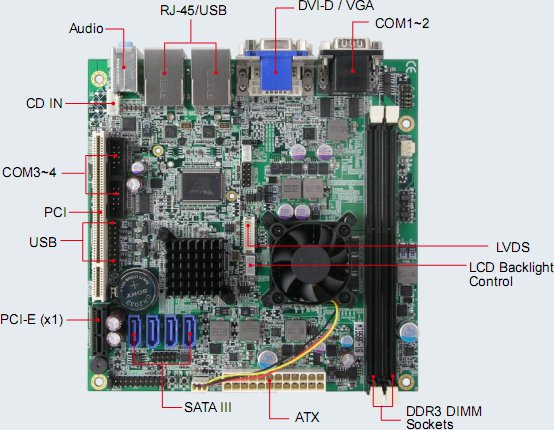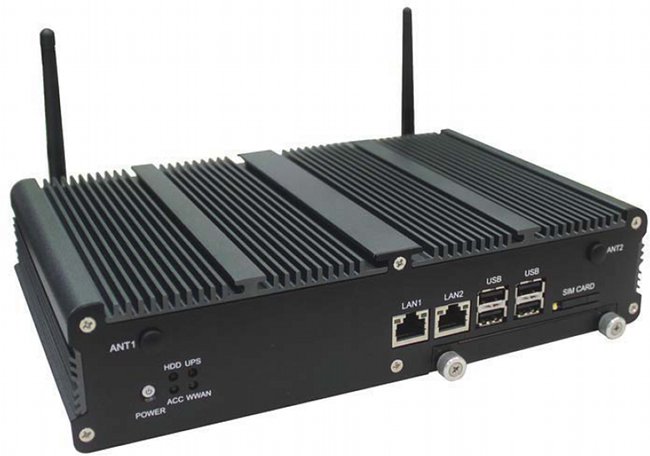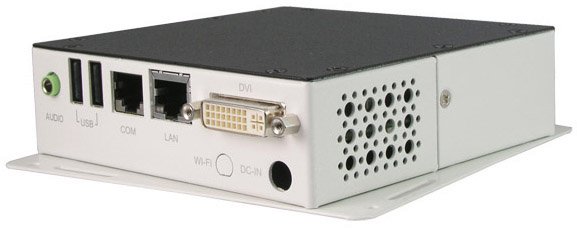Taiwan-based iBase unveiled MI958 Mini-ITX boards built around AMD’s G-Series T56N, T48N and T40N processors. The board supports up to 8GB memory, offers several PCI expansion slots, 2 Ethernet Ports, 8 USB ports, 4 serial ports, 4 SATA ports and supports dual display capability via VGA, DVi-D or LVDS. The MI958 is targeted at digital signage and surveillance systems. Here are iBase MI958 specifications and features: Processor: AMD G-Series dual-core APU T56N (1.65GHz), T48N (1.4GHz) or T40N (1 GHz) Chipset: AMD A55E FCH System Memory: up to 8GB of DDR3 RAM (2x DDR3 DIMM) Expansion Slots: Mini PCI Express slot PCI Express x1 slot PCI slot Networking: 2 x PCI-E Gigabit Ethernet Other I/O: External: VGA DVI-D 2 x Serial port 4 x USB 2.0 Audio: mic in, line in, line out Internal: LVDS 4 x USB 2.0 2 x Serial port 4 x SATA Digital I/O (4 in, 4 […]
Installing and running Xibo Linux Python Client in Acer Aspire One D255E
I have tried Xibo Linux Python Client 1.3.0 on my Acer Aspire One D255E netbook, here are the steps I followed. Install Ubuntu 10.04 LTS Since the client is only officially supported in Ubuntu 10.04 LTS, I had to install it first. After installation the network (ethernet and wifi) does not work, please visit Installing Ubuntu 10.04 LTS in Acer Aspire One D255E for the instructions to resolve the networking issues as well as make the SD card reader work properly. Upgrade Xibo Server to version 1.3.0 The next step I did was to update the Windows XP server to version 1.3.0. I followed parts of the server installation instructions I previously wrote for version 1.2.0. Download xibo-server-1.3.0.zip Extract its content to c:\xampp\htdocs\xibo Run XAMPP Control Panel and start Apache and Mysql. Go to http://localhost/xibo Enter the admin username and password, it will ask you if you want to do […]
AMD G-Series Vehicle Computer: Portwell PCS8277
Portwell announced a vehicle PC (The PCS-8277) that features an AMD G-Series processor (T56N), 2 bays for SATA devices, 2 gigabit Ethernet ports, 2 USB port, support for wireless networking (3G, Wifi etc..) and a GPS receiver. This type of device is well suited for applications such as digital signage in public transport (subway, buses). PCS-8277 In-Vehicle PC has the following system and I/O specifications: CPU: AMD G-T56N Dual Core 1.6GHz System Memory: 2 x DDR3 1066MHz SO-DIMM up to 8GB Chipset: AMD A55E Controller Hub lrDA: IrDA (SIR, Consumer IR) with TTL level Audio: Realtek ALC662 HD Codec onboard Expansion: 2 x 2.5” drive bay for SATA Type Hard Disk Drive / SSD SIM Card Socket: 1 x SIM Card socket supported onboard with eject MIO: 3 x RS-232 (2 with RS-422/485) DIO: Port 4 in and 2 out with Relay 12V / 80mA USB: 4 x USB 2.0 […]
Xibo Digital Signage Version 1.3.0 Released
Xibo has just announced the release of Xibo 1.3.0 (codename: “Faye”). Bear in mind that this is a development release and is not supposed to be used in production environments. The next stable release will be version 1.4.0 and The current stable version is 1.2.2. If you would still like to evaluate Xibo 1.3.0, you may download it at https://launchpad.net/xibo/1.3/1.3.0 New features in Xibo 1.3.0: Permissions Overhaul: The most significant change in 1.3.0 is the permissions system in the server interface. This update introduces individual and group permissions for: Layouts Library Media Regions Region Media Assignment It is also now possible to assign permissions to “Everyone” on all of the above items. Media Manager Homepage: A simple user interface for managing layout/media assignments that the user has access to. This “homepage” can be assigned on a user by user basis. Customer Counter: The Python client has been enhanced to support […]
AMD G-Series based Digital Signage: Ibase SI-18
Ibase announced a digital signage player – the Signature Book SI-18 – based on the dual-core AMD G-Series T56N running at 1.6 GHz. The IBase SI-18 is currently sold with 2GB RAM and a 160GB 2.5″ HDD, but it can support up to 4GB of RAM and 1TB of disk storage. It also features DVI output, gigabit Ethernet, two USB ports, an audio jack, a serial port and a Mini PCI slot for Wi-Fi or Bluetooth support. The device weights 800g and just measures 125.5mm (W) x 125.5mm (L) x 36 mm (H). IBase claims it is the smallest x86 digital signage player in the world. Ibase SI-18 Digital Signage Player Here are Ibase SI-18 specifications: System Mainboard EB900 CPU Type AMD G-Series Dual-Core APU (Accelerated Processing Unit): T56N=1.6GHz @ 18W TDP CPU Package 413-BGA Chipset AMD A55E Controller Hub Memory DDR3-1066 Graphics ATi Radeon HD6310 series graphics processing system […]
Video Wall with Beagleboards and ffmpeg
There was a 6-Screen Video Wall at Embedded World 2011, powered by 6 Beagleboard xM (based on Texas Instruments OMAP 3 running @ 1Ghz – Cost: 149 USD / piece), connected vi Ethernet. In the video they explain that the system is running Linux Ångström and the video is played and synchronized over Ethernet with ffmpeg. After doing some research on how to do this, they are probably using omapfbplay with netsync enabled which you can compile as follows: NETSYNC=y OMAPFB=y make However, if you are using Linux Ångström, omapfbplay with netsync is enabled by default. This can also be done with the first version of Beagleboard (without Ethernet) via USB. They can also control each display independently and synchronize the mouse and keyboard thanks to Synergy. Jean-Luc Aufranc (CNXSoft)Jean-Luc started CNX Software in 2010 as a part-time endeavor, before quitting his job as a software engineering manager, and starting […]
Ayuda Splash Digital Signage Player Becomes Open Source
Ayuda Media Systems announced OpenSplash – a free, open source digital signage player at ISE 2011. Press Release Excerpt: Ayuda Media Systems (“Ayuda”) announced today at ISE 2011 that it will be open sourcing its Splash Digital Player. Dubbed “OpenSplash”, it is a free, multi-platform open source player that can be driven by any content management and scheduling system. “Offering a free, open source media player will enable a new wave of innovation in the signage industry” said Andreas Soupliotis, President & CEO of Ayuda. “There are a multitude of software vendors in the space that basically all do the same thing – push content from a content management system (CMS) to a network of players. Some do it a little better than others but the differentiation of identity is just not there. If there were a standard open software player that the industry rallied behind then everyone could focus […]
Near Field Communication (NFC) in Public Transport
The NFC Forum, a non-profit industry association that advances the use of Near Field Communication (NFC) technology, has recently published a White Paper entitled “NFC in Public Transport” and show how you can leverage NFC technology in such environment. The whitepaper mainly focuses on mobile phones, readers and smart posters. If you need an introduction about NFC, including starting points for developing hardware and software, please read our previous blog entry first. What can NFC do in public transport ? After a short NFC introduction, the whitepaper deals with the possible applications related to public transport including: Transport timetables Link to an up-to-date weather report website Special discounted travel offers Location relevant maps Next bus arrival time Taxi services Emergency calls Phone-to-phone transfer of destination addresses and maps to taxi driver and how NFC can be used before the journey (e.g. paying for parking, using smart poster for products/services promotions […]









